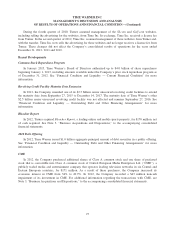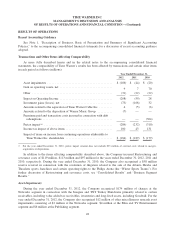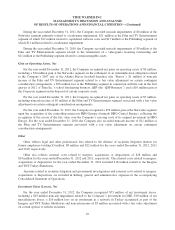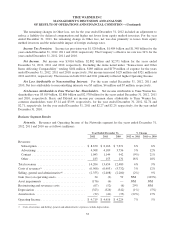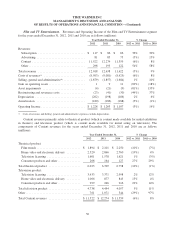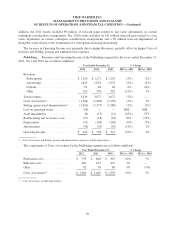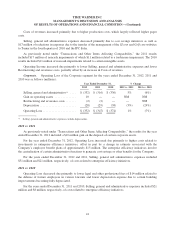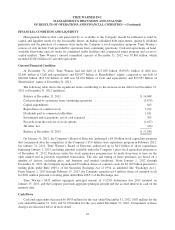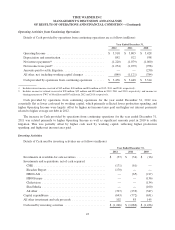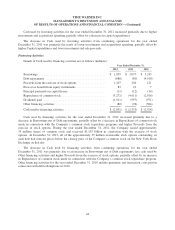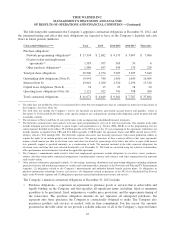Time Magazine 2012 Annual Report Download - page 53
Download and view the complete annual report
Please find page 53 of the 2012 Time Magazine annual report below. You can navigate through the pages in the report by either clicking on the pages listed below, or by using the keyword search tool below to find specific information within the annual report.
TIME WARNER INC.
MANAGEMENT’S DISCUSSION AND ANALYSIS
OF RESULTS OF OPERATIONS AND FINANCIAL CONDITION – (Continued)
The components of Costs of revenues for the Film and TV Entertainment segment are as follows (millions):
Year Ended December 31, % Change
2012 2011 2010 2012 vs. 2011 2011 vs. 2010
Film and television production costs . . $ 5,598 $ 5,488 $ 5,194 2% 6%
Print and advertising costs .......... 1,854 2,317 2,168 (20%) 7%
Other costs, including merchandise and
related costs ................... 1,051 1,276 1,067 (18%) 20%
Costs of revenues(a) ................ $ 8,503 $ 9,081 $ 8,429 (6%) 8%
(a) Costs of revenues exclude depreciation.
2012 vs. 2011
The decrease in Content revenues for the year ended December 31, 2012 included the net unfavorable impact
of foreign exchange rates of approximately $160 million.
Theatrical product revenues from film rentals decreased for the year ended December 31, 2012 reflecting
lower revenues from theatrical films released in 2012 of $267 million, partially offset by higher carryover
revenues from prior period releases of $60 million. The Company released 17 and 22 theatrical films during 2012
and 2011, respectively.
For the year ended December 31, 2012, theatrical product revenues from home video and electronic delivery
decreased due to lower revenues from releases in 2012 of $464 million and lower revenues of $82 million from
prior period releases, including catalog. There were 21 and 20 home video and electronic delivery releases in
2012 and 2011, respectively.
Television product revenues from licensing for the year ended December 31, 2012 increased due to higher
revenues from initial telecasts of $177 million, mainly reflecting higher fees for certain returning series as well as
the timing of network deliveries, partially offset by lower worldwide syndication revenues mainly as a result of
the initial off-network availability of The Big Bang Theory in 2011.
The increase in television product revenues from home video and electronic delivery for the year ended
December 31, 2012 was primarily related to higher electronic delivery revenues reflecting new SVOD
agreements and higher EST sales.
The increase in television product revenues from consumer products and other for the year ended
December 31, 2012 was primarily due to higher retransmission royalties received.
Other content revenues decreased for the year ended December 31, 2012 primarily due to lower revenues
from videogames released in 2012 of $548 million, partially offset by higher revenues from videogame releases
in prior periods of $203 million and higher third party distribution revenues of $49 million. The Company
released 10 and 13 videogames in 2012 and 2011, respectively.
The increase in Other revenues for the year ended December 31, 2012 primarily reflected higher revenues
from the Warner Bros. Studio Tour London – The Making of Harry Potter and higher international television
production activities for third parties.
For the year ended December 31, 2012, print and advertising costs declined mainly due to fewer theatrical
film releases. The increase in film and television production costs for the year ended December 31, 2012 was
mainly due to the mix of product released. Included in film and television production costs are theatrical film
valuation adjustments resulting from revisions to estimates of ultimate revenue for certain theatrical films.
37


